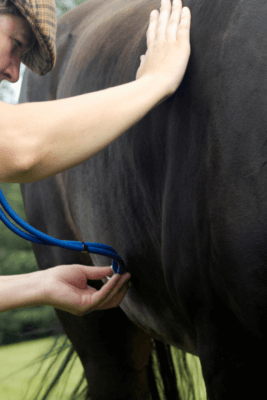Retained placenta, or retained fetal membranes, is one of the most common post-partum issues in mares. Retained placenta has a high occurrence in Friesian horses, some experts estimating as high as 30-50% occurrence in normal births. In a normal birth, the mare will deliver the placenta shortly after birth. Mares are diagnosed with retained placenta if the placenta has not been delivered within 3 hours of post-partum. This issue can be life-threatening if it is not diagnosed and treated quickly.
There are some risk factors that will make a mare more likely to experience a retained placenta – difficult births, history of retained placenta, an excessive amount of fetal fluids, intervention during birth, and advanced age. This is not an exhaustive list. Breeding can also play a part in retained placenta occurrence, as displayed by the high incidence rate in Friesian mares.
While retained placenta can be very dangerous if not diagnosed and treated, it is very treatable and often has a very positive outcome. If your mare has had this issue during a previous foaling, she is more likely to have it again. Knowing what to watch for, how to treat, and when to call the vet will reduce the risks for your mare.
Side fact – mares are more likely to retain a placenta at the tip of the non-pregnant horn, possibly due to the better connection of the microvilli compared to the pregnant horn.
Diagnosis
Retained placenta can come in two variations – one where the placenta is protruding but not delivering and one where a small piece of membrane is still within the uterus. If your mare has a protruding placenta, it is recommended to tie the placenta up (to her tail) to prevent her from stepping on it. Be cautious with maiden mares as they may get nervous when you tie up the placenta.
After foaling, if your mare did deliver the placenta, make sure to collect all of it and place it in a bucket or in a bag for your veterinarian to examine. The veterinarian will examine the entire placenta to make sure all of the pieces were dispelled from the uterus.
Treatments
Early diagnosis and treatment can prevent severe issues such as metritis, septicemia, and laminitis. Treatment for retained placenta can be done locally and systemically. The goal is to maintain uterine contractility, decrease uterine inflammation, and control bacterial growth. Your veterinarian can guide you in the best course of treatment for your mare, her medical history, and her current condition.
One very commonly used treatment is uterine lavage. Lavage will remove bacteria reducing the risk of secondary issues. It is a very useful treatment for mares with a small piece of membrane in the uterus. Uterine lavage can be done in a few different ways with different frequency levels depending on the specific case.
Another common treatment for retained placenta is the use of uterotonics – chemicals used to induce contractions. Oxytocin in small doses is a common choice for veterinarians. Calcium is another commonly used uterotonic, especially in Friesian mares. Some veterinarians routinely administer calcium to draft mares or high-risk mares after foaling to reduce the risk of retained placenta. We have not done this, but I have heard of good results from this practice. This therapy method is often combined with lavage for better results.
Some veterinarians will do a physical manual removal if the placenta is protruding. General transaction on the placenta can be the little extra needed for removal. This is not something you should attempt yourself. It is very easy to break the placenta rather than removing it. This will lead to a more complicated retained placenta. It can also lead to uterine inversion, prolapse, lacerations, and even hemorrhage.
Post-Expulsion Care
Broad-spectrum antibiotics and non-steroid anti-inflammatory are generally prescribed for mares with the retained placenta after the placenta has been removed. This combination of medication works to prevent infection, reduce inflammation and help with pain management.
The take-away message for today – retained placenta is life-threatening if not properly treated. Thankfully, most cases of retained placenta are easily managed when they are diagnosed early.
Getting your foaling kit together? Check out our list of Foaling Kit Must Haves!

I’ve been around horses my entire life, but my Friesian journey started just over 20 years ago. Our horses have always been a part of our family. They have traveled with us as we relocated from Vermont to New York to Iowa and finally, to Arizona. I can’t wait to share our story with you!
Related
Mar 19, 2021
Common Signs and Treatment of Retained Placenta in Friesian Mares

Leave a Reply Cancel reply
@starlitridgefriesiansandfells
LET'S BE FRIENDS ON INSTAGRAM
[…] Retained placenta […]